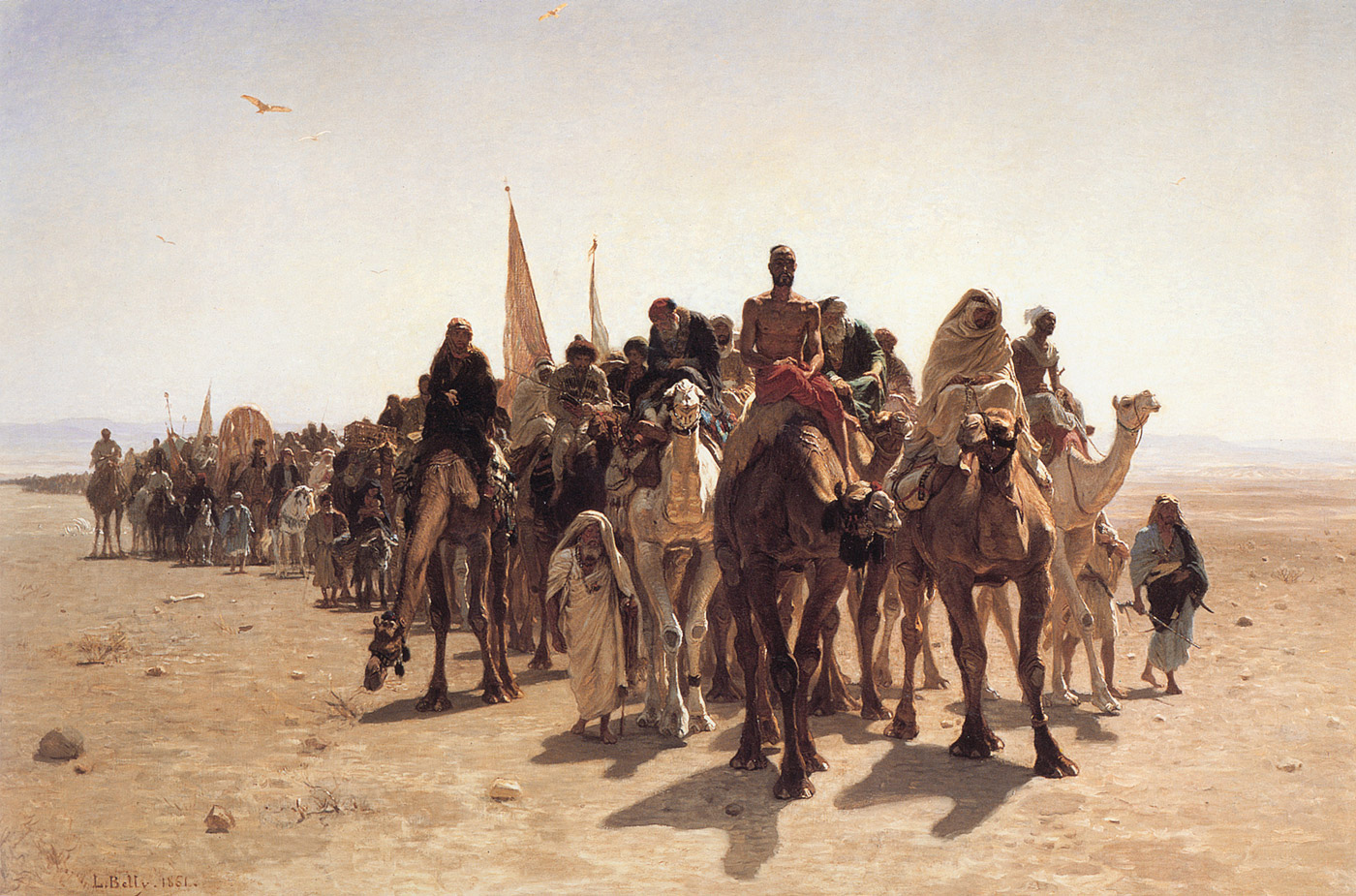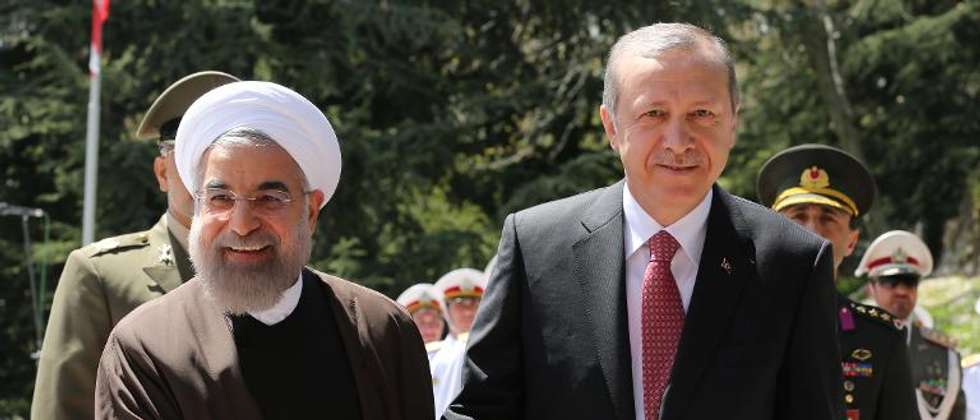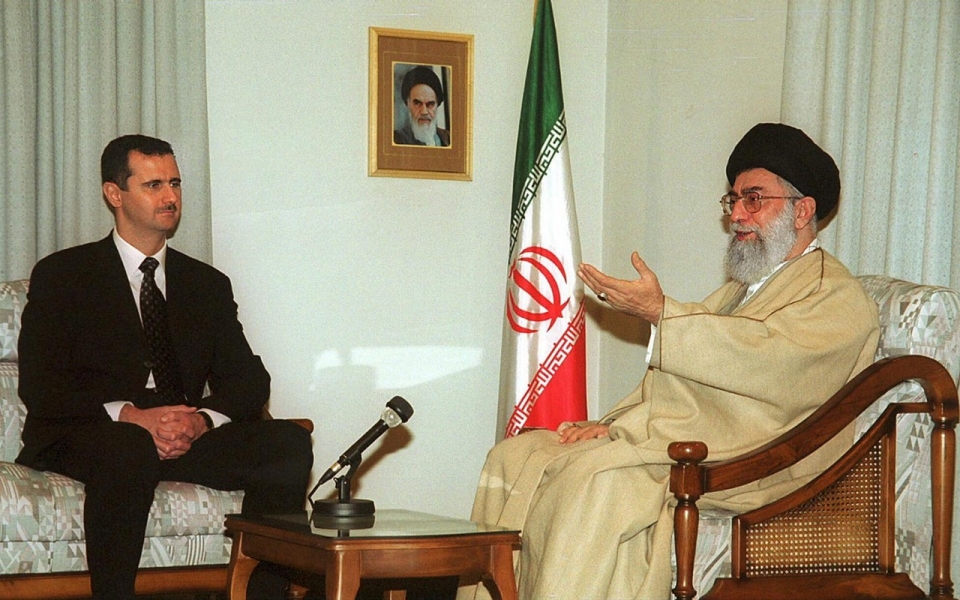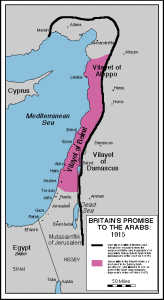First act of a process towards a new stability. The ideological veto to the Islamic Republic of Iran is breaking down, with effects that might even change Middle Eastern balance of powers
by Glauco D’Agostino

Leon Belly, Pilgrims Going to Mecca, 1861 (Musée d’Orsay, Paris, France)
The Entente constructive sense
Lausanne back in history as a symbol of agreement and restructuring of relations between States. Just as in 1923 Turkey defined its boundaries right in the Swiss city, challenging the victorious Allied Powers on the results of iniquitous 1920 Treaty of Sèvres (see map below), and as well as in 1932 in the same place UK and France enabled Germany to suspend payments for war claims laid down by the equally unfair 1919 Treaty of Versailles, as well in Lausanne the “framework” agreement reached early last April by USA, Russia, China, Great Britain, France, Germany, and the European Union with Iran sets how they allow the Islamic Republic to develop its own nuclear program, by resulting in a removal of sanctions established by the UN Security Council in 2006.

All three mentioned international conferences share a will to reach a compromise for repairing unfair burdens imposed upon the sovereignty or international viability of as many States. The most significant difference, however, is that after World War I the triumphant warring parties had raged on two Empires having lost the conflict, and which the retaliation heel was placed on; whereas, in the case of Iran, the fury against it had no justification, but an opposition to unwelcome internal adjustments by super-powers or, after USSR collapse, by the sole global super-power: a kind of excommunication, as it had represented the only reality refractory to an “obligation” for aligning itself with one of the Cold War factions.
Sure, the April 2015 Agreement is only a framework, and there are many obstacles governments (especially US and Iranian administrations) will have to overcome in their respective Legislative Assemblies, before the agreement can find an actual formulation in a shared specific text.
However, beyond the contents about the quarrel on nuclear power, this agreement with Iran takes on a much greater value with regard to relations between the Middle Eastern States and international powers and, certainly an issue of relevant complexity, to those ones among the major regional players in the area.
Meanwhile, Iran gains two significant results:
a) It is accepted as a direct (and not by proxy) negotiating partner in international topics of regional relevance and not only;
b) The ideological veto to the Islamic Republic of Iran, that had kept it at the edge of the events and political discussion for resolving so frequent territorial, ethnic and religious disputes in the area, is breaking down.
But the inclusion of Iran in this context, just because it generates the acknowledgment of importance of its contribution to a sturdy and reliable regional relations building, produces effects that might even change Middle Eastern balance of powers:
1. It could start a discussion for tidying territorial structure, and redefining dependencies, alliances and forms of political solidarity;
2. It may help to reconcile the relationships of coexistence among social, ethnic and religious groups, today jeopardized by thrusts interested to conflict and for emphasizing their divisions;
3. It might mitigate nationalistic pressures, which are unjustified in the light of the recent creation of many of the State entities currently in place.
In short, now more than ever there is a need to reach a new order in the Middle East, actually taking into account interests on the ground and balance of powers. And Lausanne could be the first act of a path in this direction, a first diplomatic event aimed at a broader agreement, which would stabilize the region on a realistic and actual basis and not on century-old assumed power assignments.
Perhaps, the Middle East needs a new Congress of Vienna, an analogous conference to that one which enabled Europe to permanently organize itself, following the dangerous and demagogic adventures resulted from the French Revolution. And you can do it, but it will be involved all carriers of territorial, social, and ideal demands, with no a priori exclusions and closures as a matter of principle.
Turkish-Iranian antagonism and the Tehrān-Damascus axis
Obviously, this road is paved with pitfalls, due to rivalries on the field. Without diplomatic feigning, an antagonism among the three major regional powers is evident: Iran, Turkey and Saudi Arabia are engaging in a struggle for the control of areas of influence, which each of them longs for. But pressures caused by non-institutional political and religious actors are not to be underestimated, because they are not bit-part players in the regional balance and, as exponents of pressing popular demands, require listening.

Following Lausanne, the first problems have soon emerged. Ankara concerns have publicly surfaced, by raising the voices of confrontation with Tehrān, albeit they have been led without reaching a level causing worry of an irreparable breaking. During April 7th meetings Turkish President Erdoğan has had in Tehrān with Iranian President Ruhani (photo above) and the Supreme Guide Āyatollāh Khāmene’i, prominent contrasts appeared on their respective positions concerning Syria and Yemen, the two thorniest issues in the present Middle East. Nonetheless, considerations prevailed about priorities of the good neighborly relations involving both countries (which have been respecting each other for centuries), being aware of their responsibility taken towards communities far more extensive than those found within their national borders, due to charges of historical and religious importance. “The two countries share a common border, which is the most peaceful border in the Middle East since the 17th century, and they have substantial energy and economic ties”, said Fadi Hakura, an expert on Turkish affairs at the Royal Institute of International Affairs Chatham House. A judgment helping to understand a substantial Turkish acceptance of the Iranian role.

On the table, however, an evaluation of the Iran-Syria ironclad pact, which has been lasting for 35 years with Ankara disappointment, is mainly unavoidable. To date, for almost a year, it has been facing the unusual situation of a new supra-national institutional entity, the Islamic State, which is able to control borders, enforce decisions of its government, exploit energy resources, levy taxes. Certainly, the link between the Āyatollāhs and Asad’s clan (Baššar al-Asad with Rahbar Khāmene’i in the photo above) bases its strength at least on three basic elements making synergy:
a) A common historical interest to master respective nearby areas, specifically Lebanon for Syria and Iraq for Iran;
b) Different targets of their political action, because Syria is historically devoted to the implementation of a pan-Arab unity, and Iran is aimed at creating an Islamic universalism;
c) A will to overcome a sectarianism possibly resulting from their ideal positions (Ba’athism for Syria, revolutionary Shi’ism for Iran), with the purpose of achieving mutual non competitive benefits.
Such a reading might actually explain this alliance strength, dispelling concerns by those who, among Sunnis, conceive Tehrān-Damascus cartel as established on the assumptions of shared Shi’ite cult, because, as it’s known, Syrian regime has secular nature, and among Twelver Shi’ites (the Iranians’ religious observance) some people don’t even deemed as Muslims the `Alawītes (the religious observance of Asad’s clan in power, a minority in Syria). It would be, however, a strategic political and economic pact, also facilitated by the growing Iranian popularity to Arab masses, regardless consonance with respect to the Shi’ite dogma or devotional practices.
Syria-Iran partnership has largely historical reasons, giving an account of its defensive character: namely, the Ṣaddām Ḥusayn’s Iraqi aggression in 1980 against the neo-Islamic Republic of Iran; and the Israel’s against Lebanon in 1982. The background is of course the Islamic Revolution in Iran in 1979. We are in the very Cold War, and super-powers play at a worldwide war by proxy, relying on the loyalty of their allies. In the Middle East, the USSR had strong relations with Syria, especially for military aid, while the United States focuses on the role of Israel, Turkey, Saudi Arabia and Iran. The Shāh’s fall and the onset of a third wheel, Khomeini’s Iran, which refuses to bow down in front of the loyalties demanded by super-powers, undermine US and USSR basically concordant strategies, the ones have not allowed since 1945 for exceptions to this steel pattern. Talk about a Cold War! Evidence of this assumption is the fact that USA and USSR bring together as allies in supporting Ṣaddām Ḥusayn’s Iraq (yes, the raʾīs badly dismissed in 2004) in the war against Iran; and that both of them look at a dawning Tehrān-Damascus axis with suspicion and hostility. In fact, not as much paradoxically given its progressive bankruptcy domestic situation, the USSR will line up with the American international policy in the Middle East since the second half of the 80’s.
The breakdown of Cold War paradigm
In this regard, several analysts agree the birth of the Islamic Republic of Iran has been the political act which caused the breakdown of the shared paradigm about alternative and exclusive domain (euphemistically, the Cold War, in fact), before leading to Soviet Union expiration; in fact, the USSR end has been induced by Afghanistan deadly war of invasion, precisely launched to counter the political changes in Tehrān. And the Iranian role will have come out even more enhanced a few decades later, when its allies of Ḥizb Allāh resistance movement (surely loyal to Tehrān on grounds of religious observance) will have got 14 seats in the Lebanese Parliament in 2005, have entered Fu’ād as-Sanyūrah’s government, have bravely opposed the Israeli military reaction one year later, and in 2008, via Dōḥa agreements brokered by the Emir of Qatar Shaykh Ḥamad bin Khalīfa ath-Thānī, have won for them and the opposition allies many as 11 ministries, a number as to be a decisive factor in government decisions.

Same evolution in the direction of strengthening Iranian interests will have had the events involving the Gulf. In 1981, the creation of the Cooperation Council for the Arab States of the Gulf (composed by Saudi Arabia, Kuwait, Bahrain, Qatar, United Arab Emirates and Oman: their Rulers in the photo above) acts as a wall against potential attempts of Gulf economic and political control by the new State of Iran, while ignoring the threat posed by Ṣaddām Ḥusayn. After having rejected the Iraqi attack, supported for eight years by USA and USSR, Iran can see finally neutralized the dangers emanating from its western borders with the Second Gulf War; by contrast, the States of the Arabian Peninsula consider as worrisome the inevitable increase of influence Tehrān exerts on the predominantly Shi’ite Iraqi population. So, they don’t allow an Iranian involvement in talks for a political order of the area, instead negotiated with Washington. Then US President, Bush senior, realizes that an agreement excluding Iran, a proven regional power, will have always left an unknown factor in the effectiveness of an understanding system, which at that time also affects the sensitive peace-building in Palestine (for the establishment of Palestinian National Authority) and Yemen (after unification of the two States), until it involves the institutional beddings of new post-Soviet States in Transcaucasia and Central Asia, all contexts anyway affecting Iran.
The actuality of these arguments is evident, since all these realities are still impacted by fibrillations and conflicts, a result of failed both global and regional agreements.
The current situation of uncertainty and tensions in the Middle East has therefore historical roots. The fact is that international bipolar system was binding allies to their respective ideological network, making the behaviors of minor allies more “reliable”, because it demanded them to apply a template (either capitalistic or communist), each one deemed as universal.
Nor the establishment of Non-Aligned Movement led to appreciable results. It was formalized in 1961 in Brioni, Yugoslavia, especially at the behest of leaders such as Nehru from India, Soekarno from Indonesia, Nasser from Egypt, Nkrumah from Ghana and Tito from Yugoslavia. Leaving aside a prevalence of figures from socialist and communist ideologies (Boumédiène, Fidel Castro, and Mugabe among others have taken office as Secretary General of the Movement), acceding countries have proceeded often separated during international crises up to the end of the Cold War, following instructions given by one of the two blocks. In addition, a range of unilateral doctrines on security (but specular to one another) allowed military, political, economic and cultural pressures, making unlikely the expansion of autonomous views or initiatives for any individual allied State.
Thus, after World War II, the United States had developed the Kennan’s Doctrine of containment, immediately applied by Truman in the Middle East to Iran and Turkey, and subsequent Presidents would have had the same approach of security protection from the Soviet threat. By contrast, the Soviet Union had begun to implement in the Arab world the theory of correlation of forces, which, being strictly derived from the Marxist-Leninist ideology, gazed a strategy of linking social, economic, political, and military subjects, States and inter-state systems, aimed at the seizure of power with a revolutionary and anti-capitalist function.
On the basis of this assumption, at the same time a doctrinal and pragmatic issue, the USSR had first ridden the 40’s and 50’s nationalist and anti-colonial wave, and then, following the 1956 Suez crisis, had caused or supported the rise of nationalist military regimes in Egypt, Sudan, Iraq, Algeria, North Yemen, Syria, and, later, South Yemen and Libya. Actually, despite the presence of strong communist parties (especially in Sudan till the 1971 repression by Jaʿfar Muḥammad an-Numayrī, and in Iraq up to the Ṣaddām Ḥusayn’s in 1979), no pro-Soviet revolutionary movements occurred, and only in South Yemen a Marxist-Leninist-oriented regime has ruled the country with strong dissent since 1978, until the dissolution of the State in order to converge to a unified Yemen in 1990.
The other country of the area resulting as a victim of communism has been Afghanistan, even before the Soviet occupation, when Communist-inspired People’s Democratic Party had seized power in 1978, running it even after the liberation, until the 1992 fall of Moḥammad Najibullah Ahmadzai. For all other not US-allied countries, the Soviet diplomatic ability imposed (also in the international lexicon) a use of euphemistic qualifiers, such as “non-capitalist”, “national-democratic”, “socialist-oriented”. The same it couldn’t just do for the Islamic Republic of Iran, despite the Soviet attempts made within the revolutionary movement to turn the outcome of the insurgency against the Shāh into a social-communist trend: a slap for Moscow anti-capitalist appeal, but also a debacle for Washington exclusive claim in fighting communism.
The original sources of destabilization
 This analysis, however awkward for chancelleries and the corresponding public opinions, cannot stop taking the consequences suffered by the Middle East upon the Cold War legacy of compromise. You should go at least at the sources of destabilization: a divide et impera colonialist view, whereby Arab unity was not allowed after the Ottoman Caliphate dissolution (see map on the side); and whereby at the Conference of Tehrān in 1943 the Allies imposed to Iran, formally neutral during both World Wars, to keep Anglo-Soviet troops, operating in the country since 1941, within its boundaries. In turn, this action had behind it the 1907 Convention of St. Petersburg, which had divided Persia into British and Russian spheres of influence (by treating it, in terms of military strategy, as two entities satisfying exogenous, differing, while competing logics), and the Anglo-Russian invasion of the country in 1914.
This analysis, however awkward for chancelleries and the corresponding public opinions, cannot stop taking the consequences suffered by the Middle East upon the Cold War legacy of compromise. You should go at least at the sources of destabilization: a divide et impera colonialist view, whereby Arab unity was not allowed after the Ottoman Caliphate dissolution (see map on the side); and whereby at the Conference of Tehrān in 1943 the Allies imposed to Iran, formally neutral during both World Wars, to keep Anglo-Soviet troops, operating in the country since 1941, within its boundaries. In turn, this action had behind it the 1907 Convention of St. Petersburg, which had divided Persia into British and Russian spheres of influence (by treating it, in terms of military strategy, as two entities satisfying exogenous, differing, while competing logics), and the Anglo-Russian invasion of the country in 1914.
Despite such a past, Iran is the one country in the present Middle East can boast a state and territorial continuity, dating back, if not to the 1501 Safavid Empire establishment, at least to the birth of Zand’s Persian Empire in 1760. Turkey itself, at that time cynically at the mercy of the victorious armies, was formed in 1923, and struggled for years to restore a semblance of State, although by then disengaged from traditional basics constituting its own law and history. None of the other 13 Middle Eastern current States, heirs to the authority of the disrupted Ottoman Sultanate, has more than a century of life in the guise of an independent entity, bypassing the Sultanate of Oman of as-Saʿīd Dynasty, dating back to 1741, and, however, never included in the Ottoman rule, but with a disguised British influence. All others are an expression of the Franco-British diplomacy fertile imagination and of the resulting adjustments produced by the subsequent US replacement of influence, via the decolonization following World War II balances. In particular:
1. The independence of the following States comes from the end of British international mandates or protectorates:
- Saudi Arabia and Iraq (1932), Transjordan (later Jordan) (1946), the Jewish State (1948), Kuwait (1961), Bahrain, Qatar and the United Arab Emirates (1971);
2. The independence of the following States comes from French decolonization:
- Syria (1944) and Lebanon (1946);
3. Republic of Yemen comes from the autonomous convergence of two independent States: it was established in 1990 by the unification of the Yemen Arab Republic (North) and the People’s Democratic Republic of Yemen (South). For their part, the first had declared its independence from the Ottomans in 1918, and the latter in 1967 from the British;
4. The State of Palestine comes from an international recognition. In 2012 the UN General Assembly admitted it as a “non-member permanent observer State”, following the 1993 Oslo Accords and the adoption of UN Resolutions 242 by Security Council in 1967 and 181 by General Assembly in 1947.
Hope for a renewed Middle East
All the above considerations are not about a barren knowledge of history, as a petrified witness available to experts in the field, but recall to awareness about some realities which, possibly, we must question and face today with a spirit of freedom and justice:
- a phase of history itself ended with a depletion of specious ideological justifications, characterizing last century;
- a clarification of real objectives each country and their populations licitly aspire to is a duty for the international community as a whole;
- a multi-polar world cannot by now allow anti-historical diktats, resulting from global conflicts dating back 70 or 100 years;
- a management of tensions in sensitive geo-political areas, in the partisan way it was performed in the last century, is no longer sustainable; that is, it was always carried out for the benefit of some, and by mortifying aspirations of others, as if by a biblical curse;
- forms of seclusion and ideological apartheid against theories, movements of thought, political and religious organizations, even against entire peoples and States, in the name of unilateral logics deemed universalist, are no more reasonable (if they have been so in the past).
A utopian framework? Maybe. It’s hard to imagine how the Middle Eastern future will be. Goodwill and perseverance in dialogue are required for this purpose.
Nowadays, the United States, probably pursuing once again pragmatic interests and playing the role is definitely up to it, seems opening to feeling and dialogue. Surely, it must prove, too, “the divine destiny” reserved to it “to establish on earth the moral dignity and salvation of man” is now exhausted. We are referring to John Louis O’Sullivan words of 1839, depicted a few years later in the expressions addressed by American missionary William Goodell to some Lebanese people: “We have come to raise your … population from that state of ignorance, degradation, and death which you are fallen, to do all the good in our power”. Sadly, a number of actions carried out in the Middle East in the first decade of this century demonstrated again this wretched messianic fundamentalism. But we do believe this is a story of the past!
By contrast, a task is up to the Middle Eastern ruling classes: taking up the destinies of their people, to reconstitute a basis of common intents, if not in politics, designed at least to a cohabitation and a rediscovery of common values; to demonstrate, eventually, the ability of representing not only their distinctive functions, but also and above the material, spiritual and traditional needs of their people.
For a renewed Middle East!


